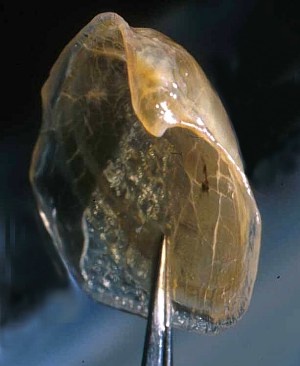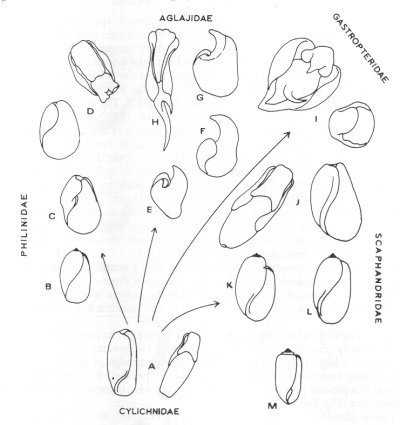Shell of Aplysia
August 30, 2000
From: Yoshiaki J. Hirano

Dear Bill,
I was asked by a friend of mine about the shell of Aplysia spp. He is interested in whether the shell functions, for example, as a support structure for body shape or just a trace inherited from more primitive forms of opisthobranchs. My impression is the latter, so I took some examples apparently showing a trend of shell reduction from Akera through Aplysia to Notarchus species in Anaspidea. I would be happy if you or someone else kindly give us some idea concerning this question. I have attached a photo of the shell of Aplysia juliana.
Best wishes,
Yoshi
hiranoyj@earth2.s.chiba-u.ac.jp
Hirano. Y.J., 2000 (Aug 30) Shell of Aplysia. [Message in] Sea Slug Forum. Australian Museum, Sydney. Available from http://www.seaslugforum.net/find/2928
Dear Yoshi,
I agree that the shell of Aplysia is a remnant from ancestors with larger more calcified snail-like shells. I have prepared a new page showing some examples of this.
This gradual loss of shell is found recurring many times within the opisthobranchs. I have included alongside an example amongst the philinoideans from Cylinchna with a heavily calcified external shell giving rise to the aglajids and philinids in which the shell is flattened, fragile and internal, and the gastropterids, which if they have an internal shell, it is a fragile and uncalcified.
[FROM: Rudman, W.B. (1978)
A new species and genus of the Aglajidae and the evolution of the philinacean opisthobranch molluscs. Zoological Journal of the Linnean Society, 62: 89-107.]
Have a look at the pages on How snails became slugs and What is a slug?.
Best wishes,
Bill Rudman.
Related messages
-
Aplysia shell from Majuro
From: David Kirsh, November 29, 2007 -
Shell reduction in the Sea Hares
From: Bill Rudman, August 30, 2000
